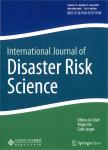Evaluating the Influence of Multisource Typhoon Precipitation Data on Multiscale Urban Pluvial Flood Modeling
作者机构:Key Laboratory of Geographic Information Science(Ministry of Education)East China Normal UniversityShanghai 200241China Shanghai Typhoon InstituteChina Meteorological AdministrationShanghai 200030China Key Laboratory of Numerical Modeling for Tropical Cyclone of China Meteorological AdministrationShanghai 20030China Institute of Eco-ChongmingEast China Normal UniversityShanghai 202162China Research Center for China Administrative DivisionEast China Normal UniversityShanghai 202162China National Disaster Reduction Center of ChinaBeijing 100124China State Key Laboratory of Estuarine and Coastal ResearchEast China Normal UniversityShanghaiChina
出 版 物:《International Journal of Disaster Risk Science》 (国际灾害风险科学学报(英文版))
年 卷 期:2022年第13卷第6期
页 面:974-986页
核心收录:
学科分类:08[工学] 081501[工学-水文学及水资源] 0815[工学-水利工程]
基 金:This study was sponsored by the National Natural Science Foundation of China(Grant Nos.41871164,41806046) the Shanghai Sailing Program(Grant No.21YF1456900) the Shanghai Philosophy and Social Science Planning Program(Grant No.2021XRM005) the Fundamental Research Funds for the Central Universities(Grant No.2022ECNU-XWK-XK001)
主 题:City and neighborhood scale Flood validation Multisource precipitation data Pluvial food modeling Shanghai
摘 要:Based on station precipitation observations,radar quantitative precipitation estimates(QPE), and radar fusion data during Typhoon Fitow(2013), the influence of multisource precipitation data on multiscale urban typhoon pluvial flood modeling is studied. Using Shanghai, China,as the study area, a simplified 2D hydrodynamic model is applied to simulations. Combined with actual flood incidents reported by the public and soil moisture data, we perform multiscale verifications and determine the applicability of three precipitation datasets in the modeling. The results are as follows:(1) At the city scale, although QPE have higher spatial resolution, these estimates are lower than station observations. Radar fusion data have both high accuracy and high spatial resolution. For flood depths above 5 cm, the radar fusion precipitation scenario can improve the matching probability by 6%.(2) At the neighborhood scale, the radar fusion precipitation scenario can effectively mitigate the problems of an uneven spatial distribution of stations and a weak QPE to accurately capture pluvial details.(3)One fixed-point assessment shows that different precipitation data have little influence on the temporal characteristics of the modeling result-all three types of data can accurately reflect flood occurrence times. This work can provide a scientific basis for constructing effective urban pluvial flood monitoring systems.



